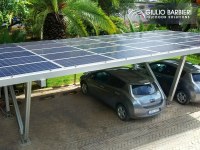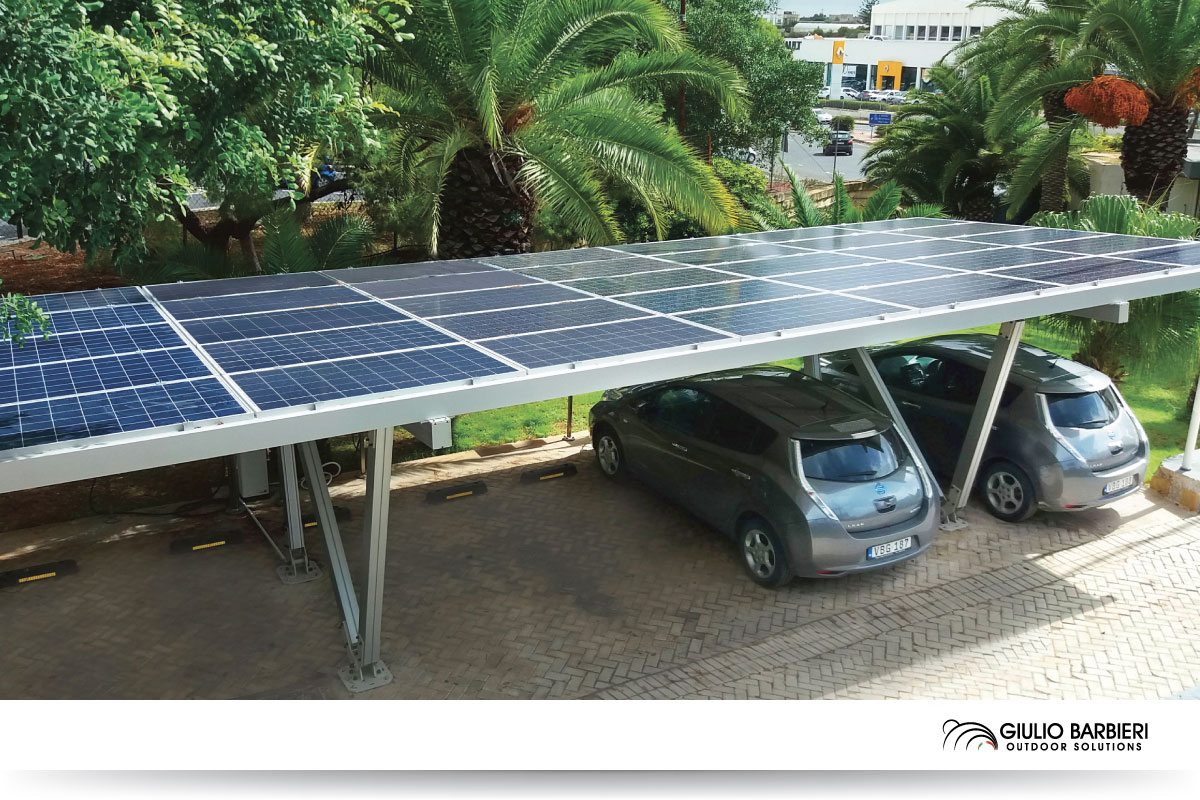What is a Solar Carport?
The Solar Carport is a canopy that is entirely covered with solar panels and very easy to assemble. However, despite the simplicity of the structure, we do not recommend that you set it up on your own.
Choose experienced professionals to avoid unpleasant inconveniences. Once you have found the right person for the task and checked the local regulations in force (covered in the following paragraphs), the installation takes place in a very short time.
The Carports market is constantly expanding and, as a result, more and more companies - even the ones with no experience in the field - decide to take a shot at it. For this reason, you should rely exclusively on high-quality and certified products if you want to avoid buying canopies with poor reliability and durability.
What are the advantages of a Solar Carport?
The solar panels on the roof of your Carport can be used in different ways. The initial investment in the cost of the panels, the structure, and the workforce, will pay off in the future. In addition, when you rely on quality products, you can even achieve greater savings and economic returns than the initial expense.
Among the numerous advantages we would like to highlight:
- Protection: the first big advantage is the protection of your car (or any other vehicle) under the canopy. Being an actual shelter, it allows you to protect your assets from snow and heavy rain.
- A greater efficiency of the solar power system: a second advantage is represented by the fact that the carport allows the system to work in ideal conditions: the panels enjoy optimal ventilation on top of the canopy and, thanks to the low height, can be cleaned and monitored much more easily. The efficiency of a carport system can be increased by up to 30% if double-sided panels are installed. These panels of the latest generation are capable of producing energy on both sides by exploiting the direct sunlight as well as that reflected below the carport.
- Savings: by connecting your solar panels to the national electricity grid, you can save significantly on your bill. By installing several Solar Carports, or a single large one, you can greatly reduce your expenses on traditional energy supply.
- Earnings: you can sell the surplus energy generated, which can be inserted directly into the grid and the national market. The parameters of conversion and earnings per kW can be checked daily on the market price lists.
- Upgrading company car parks: many companies, both small and large, often have open car parks. Taking advantage of Solar Carports can be an excellent opportunity both to improve corporate sustainability and to generate savings.
- Safeguard the roof: when you accidentally entrust the installation of a photovoltaic system on the roof to unskilled companies, it is possible to incur damage to the roof covering. Using structures such as Carports, designed specifically for these tasks, allows you to avoid damage to the floor.
- Electric car/bike charging: you can recharge your electric vehicle using the Solar Carports. In this way, the stored energy can be fully utilised while the vehicle is parked and sheltered from the weather.
Solar panels are, therefore, an excellent opportunity in many respects. There are no disadvantages as the initial investment will be offset in full over the years and might even bring you earnings.
Configure your Photovoltaic Carport and send us your quote request
Types of Solar Panels available on the Market
During the installation of the photovoltaic panels, which can be connected to your own Carport, the customer has three main alternatives to choose from: Grid-Connected, Stand-Alone, and Storage.
- Grid-Connected. In this instance, the installed system is directly connected to the national electricity grid. When the system generates more energy than the total consumption of your home (or company), the surplus energy will be fed directly into the national grid, giving you excellent savings on your bill. If this happens, you will be compensated directly by your energy service provider according to the market prices. Alternatively, you can choose to sell the entirety of the energy produced.
- Stand-Alone. If there is no option of connecting to the national electricity grid, you might have to choose a stand-alone system. The energy produced can only be used to power the house or the place it is directly connected to. In case of surplus of energy, the accumulation-based system, conveys the unused energy into batteries for later use. The only disadvantage, in addition to the very high installation and maintenance costs, is that if the batteries are fully charged, and no electricity is used, the remaining energy produced is released as heat outside.
- Storage. This is a hybrid option which recently became regulated in many countries. Its operation is simple and ingenious. The system is able to direct the excess energy which hasn't been consumed, into a battery storage system, so that it can be used during the night, in the absence of solar power production. Once the batteries are charged, the system automatically modulates the panels, reversing the flow and feeding energy into the national grid.
Solar Panels: the importance of maintenance
To guarantee a high productivity of the solar panels, it is necessary to the appropriate maintenance procedures (monthly and annual). The starting point is definitely cleaning the panels. They are the most important part of the system as they contain the solar cells and components able to capture sunlight and, therefore, they require special attention. Any dust or debris could affect the quality of the conversion.
Choose carefully the cleaning products you use. There are various quality cleaning kits available on the market so that you can carry out the procedure in the most appropriate way, without causing irreversible damage. Most importantly, never use an abrasive sponge. Scratches on the panel's surface may adversely affect its performance.
As already mentioned, if you decide to install a system on the carport, it will be really easy to carry out the maintenance of the panels. The low height of the canopy increases accessibility and facilitates visual checks.
The surface of the panels is not the only element to be taken into account during maintenance (ordinary and extraordinary). Other components include:
- Battery check (in case of storage system): Lithium batteries are currently the best choice in terms of quality and durability. In any case, the operating status control can usually be managed remotely.
- Connection check: a general check on the wiring, look for any signs of wear.
- Inverter check: must be carried out by a professional, almost always at the end of the warranty period given at the time of sale (approx. 10 years).
How to monitor the system?
The monitoring your solar power system, mounted on your Carport, for example, can be linked to two implicit advantages. The first one is to measure the performance of your device so that you know how to use your system more efficiently, favouring the use of energy-saving appliances/machinery, depending on solar production.
The second advantage concerns prevention. Monitoring means being able to understand any minor problems before it's too late. The results, processed periodically or at the customer's request, are displayed directly on a monitor or on your computer.
Thanks to improvements in technology, combined with the continuous development of solar power monitoring systems, there are now convenient apps for mobile devices. Their operation is identical to that described above, but the data is sent via WiFi or mobile network directly to your phone.
The indicators and parameters which can be displayed are:
- Faults, malfunctions, or damaged parts, detected through special sensors.
- Harmful emissions prevented thanks to the use of renewable energy. The amount of CO2 not released into the atmosphere.
- Fossil fuels equivalent to the energy produced (e.g. in litres of petrol).
- The energy produced, exchanged, withdrawn, and fed into the grid.
- How much energy is produced and consumed at a point in time in kW. On certain systems, it is possible to view graphs on performance and trends of the last weeks or months.
Conclusions
In light of the observations made in the guide, the Solar Carport has proven to be a truly innovative and functional system. It allows you to protect your cars, motorbikes, bicycles, or any goods placed underneath it. In addition, it maximises the yield of old and new generation solar panels, guaranteeing considerable savings on your bill. In the article, the reader had the opportunity to find out about the latest regulations regarding permits in the various areas. Ultimately, buying a Solar Carport from professionals, allows you to make the most out of your car park by transforming it into precious sources of energy while protecting the roofing of the surrounding buildings. Appealing design, high functionality, and care for the environment are the fundamental pillars of the success of Solar Carports.



